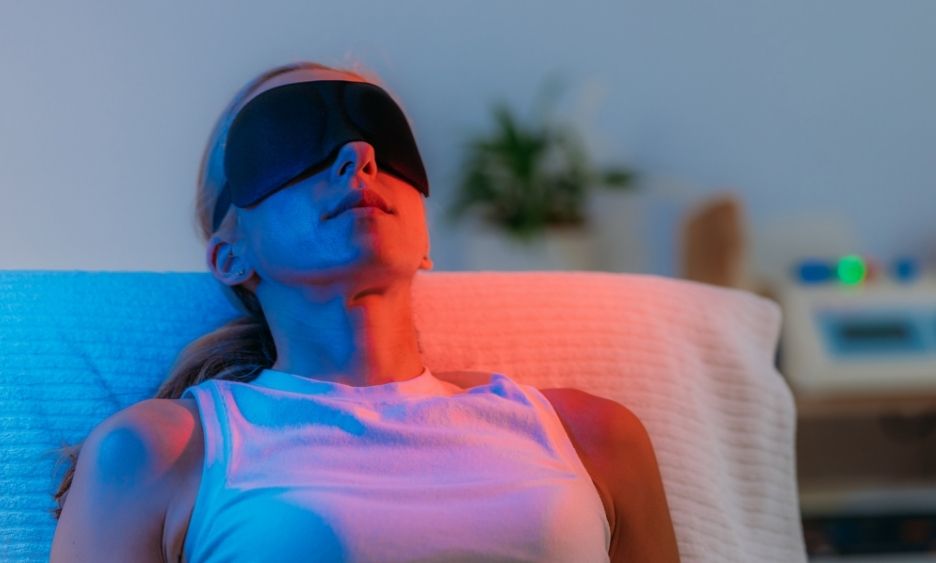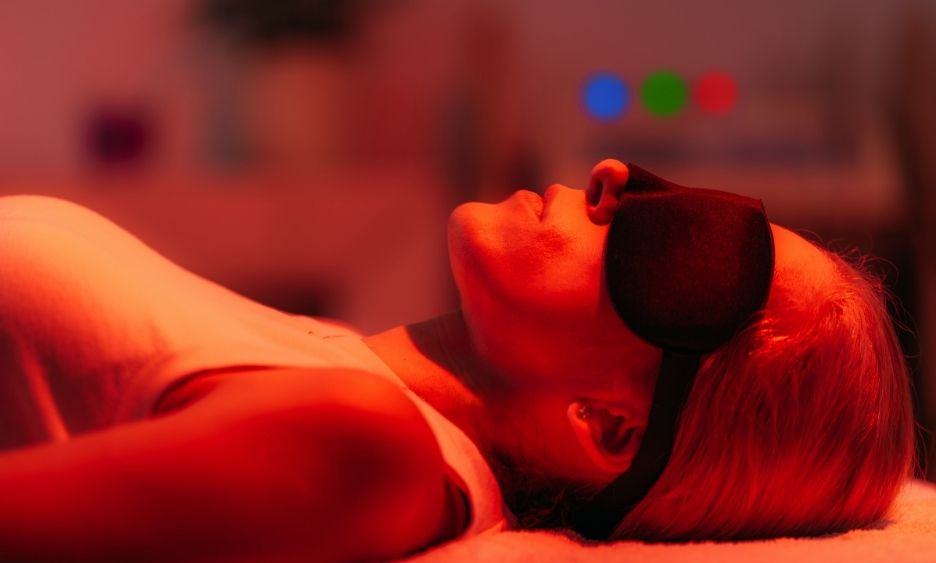Red light therapy (RLT) has become one of the most popular beauty and wellness treatments worldwide in recent years. From glowing skin and faster muscle recovery to pain relief and mood enhancement, this technology has found its way into spas, gyms, dermatology clinics, and even homes.
But as more people try red light therapy devices, especially LED masks and red light therapy panels, one concern stands out: Is red light therapy safe for eyes, and how might it affect eye health?
It’s a fair question. Our eyes are delicate, and unlike the skin, they cannot always regenerate once damaged. While most people know UV light and blue light can harm vision, many are unsure whether red and near-infrared light are safe.
The good news? At therapeutic levels, red light therapy is considered safe for the eyes, and in some cases, it may even support vision health. In this in-depth guide, we’ll explore what the science says, potential benefits and risks, and the best ways to use red light therapy for the eyes safely.
What Is Red Light Therapy?
Red light therapy (RLT) uses low-level wavelengths of red and near-infrared light (typically between 600–900 nanometers) to penetrate the skin and tissues. This light stimulates mitochondria, the energy-producing parts of cells, allowing them to function more efficiently and repair themselves faster.
This process, known as photobiomodulation, is the foundation of RLT’s therapeutic effects. By energizing cells, red light therapy promotes healing, reduces inflammation, and supports collagen production.
Common Uses of Red Light Therapy
- Skin rejuvenation – Reducing wrinkles, fine lines, and sun damage.
- Wound healing – Accelerating repair of cuts and injuries.
- Pain relief – Helping with arthritis, muscle soreness, and joint stiffness.
- Hair growth – Supporting people with genetic hair loss (androgenic alopecia).
- Mental health – Emerging research links RLT with improved mood and sleep quality.
- Eye health – Early studies suggest it may help slow retinal aging.
Why Eye Safety Is a Concern

Our eyes are extremely sensitive to light. The cornea, retina, and surrounding tissues are vulnerable to damage from intense light sources such as UV rays, lasers, or prolonged exposure to blue light from digital screens.
Unlike the skin, which regenerates more easily, the eyes cannot repair certain types of damage once it occurs. This is why people worry about whether red light therapy devices, especially LED masks or panels, could pose risks.
Red Light vs. UV and Blue Light
- UV light (from the sun or tanning beds) is harmful because it damages DNA in cells, increasing risks of cataracts and skin cancer.
- Blue light (from phones, laptops, and LED screens) penetrates deeply into the retina and is associated with premature aging of the eye.
- Red and near-infrared light, however, do not belong to these harmful ranges. They fall in the visible and near-visible spectrum, which is generally safe at therapeutic levels.
Because LED masks and red light panels shine directly on the face, it’s natural to worry: could these devices be bad for your eyes?
What Science Says: Is Red Light Therapy Safe for Your Eyes?
Research Supporting Safety
Several scientific studies have examined whether red light therapy can harm or benefit the eyes. The results are promising:
- Improves Retinal Function: Research published in The Journals of Gerontology found that exposing older adults to 670nm red light for just three minutes a day improved retinal function and slowed visual decline.
- Supports Macular Health: Clinical trials are exploring red light as a treatment for age-related macular degeneration (AMD), one of the leading causes of vision loss.
- Eye Fatigue Relief: Some studies show red light exposure may help reduce eye strain caused by prolonged screen use.
Benefits of Red Light Therapy for Eyes
1. Supports Retinal Cell Energy
The retina is one of the most energy-demanding tissues in the body, constantly processing light and sending signals to the brain. Red light therapy boosts mitochondrial function, helping retinal cells produce more ATP. This support for aging cells may slow natural vision decline and maintain overall eye health over time.
2. May Slow Macular Degeneration
Age-related macular degeneration (AMD) is a common cause of vision loss in older adults. Early studies suggest that red light therapy can improve energy in macular cells, potentially slowing the progression of AMD. While it’s not a cure, it may help maintain sharper vision.
3. Reduces Digital Eye Strain
Spending long hours on screens can cause tired, dry, or strained eyes. Short red light therapy sessions may reduce oxidative stress, improve circulation, and help the eyes recover from overuse. It can be a natural way to ease everyday eye fatigue.
4. Improves Contrast Sensitivity
Contrast sensitivity, or the ability to distinguish objects against a background, often decreases with age or certain eye conditions. Studies show red light therapy may enhance photoreceptor activity in the retina, helping the eyes process light more efficiently and improving overall visual clarity, especially for older adults.
5. Helps with Dry Eyes
Dry eye syndrome affects millions of people, particularly those who spend long hours in air-conditioned spaces or on screens. Red light therapy may stimulate the meibomian glands, improving tear production and stability. This can reduce irritation, burning, and discomfort, and new devices are being developed to make treatments more effective for chronic dry eye sufferers.
Is Red Light Therapy Bad for Your Eyes?
Red light therapy is generally considered safe, but certain situations require extra caution to protect your eyes.
1. Staring Directly into LEDs
Even though red light is safe at therapeutic levels, looking directly into the LEDs can cause temporary glare, discomfort, or eye strain. It’s best to avoid staring at the light and keep a safe distance during treatment.
2. Cheap or Unregulated Devices
Low-quality or unregulated devices may emit higher intensities or incorrect wavelengths that could harm the eyes. Using certified, clinically tested devices reduces the risk of potential damage.
3. Pre-Existing Eye Conditions
People with glaucoma, retinal diseases, or those who have recently had eye surgery should seek medical advice before using red light therapy. Their eyes may be more sensitive, and improper use could worsen existing conditions.
4. Photosensitivity from Medications
Certain medications, including antibiotics, antidepressants, and chemotherapy drugs, can increase sensitivity to light. If you take these, consult a healthcare professional to determine safe usage and exposure times.
Potential Side Effects of Red Light Therapy for Eyes
Red light therapy is considered safe for most people, but like any treatment, there can be minor and temporary side effects. These are usually mild and do not indicate permanent eye damage.
1. Using High-Intensity or Unregulated Devices
Devices that are poorly made or not clinically approved may emit unsafe levels of light or incorrect wavelengths. This can cause unnecessary irritation or discomfort in the eyes. To stay safe, it’s best to use FDA- or CE-certified devices from reputable brands.
2. Staring Directly into LED Panels or Lasers
Most red light devices are designed to be used on the skin, not for direct eye exposure. Looking directly into strong LEDs or laser-based systems may lead to glare, temporary visual spots, or strain. Always follow usage guidelines and avoid direct eye contact.
3. Pre-Existing Eye Conditions
People with eye conditions such as glaucoma, retinal disorders, or those recovering from eye surgery may be at greater risk of irritation. Their eyes are often more sensitive to light, so professional medical advice should be sought before beginning therapy.
4. Photosensitivity from Medications
Some medications, including antibiotics, antidepressants, or chemotherapy drugs, can make the eyes more sensitive to light. In such cases, even safe levels of red light might feel uncomfortable. Consulting a doctor ensures you can use the therapy without added risks.
Temporary Effects to Expect
- Mild eye irritation or discomfort
- Short-lived glare or visual spots
- Occasional mild headaches from brightness
These effects are usually temporary and do not indicate permanent eye damage.
Choosing a Safe Red Light Therapy Device
Not all red light therapy devices are equally safe, especially when used near the eyes. To protect your vision, keep these points in mind when choosing a device:
Look for FDA or CE Approval
Devices that are FDA-cleared (in the US) or CE-marked (in Europe) have undergone safety and quality testing. These certifications ensure that the device operates at safe wavelengths and intensities suitable for home or professional use.
Opt for Skin-Fitted Designs
LED masks or panels that sit flush to the skin reduce excess light leakage into the eyes. This design minimizes the risk of glare and makes treatments safer and more comfortable.
Choose Reputable Brands
Avoid ultra-cheap or unverified products sold online without clear specifications. Stick to established brands with published clinical data and customer reviews to ensure reliability and safety.
How to Use Red Light Therapy for Eyes Safely
Even when using safe devices, following a few precautions can help protect your eyes and maximize benefits.
1. Follow Instructions Carefully
Always read the manufacturer’s manual before using the device. If goggles are recommended, wear them, and never use a device on your eyes if it specifies skin-only use.
2. Use Protective Eyewear If Needed
Some higher-powered or clinical devices require protective goggles. Even if your device doesn’t mandate them, wearing glasses can provide extra safety and peace of mind.
3. Keep Sessions Within Recommended Limits
More time doesn’t always mean better results. Stick to the recommended duration, usually 5–20 minutes per session, 3–5 times per week, to avoid overexposure.
4. Consult Your Doctor
If you have pre-existing eye conditions or are unsure about using red light therapy, consult an ophthalmologist or dermatologist first. Professional guidance ensures safe and effective treatment.
Do You Need Eye Protection for Red Light Therapy?
Whether you need protective eyewear depends on the type of device you’re using.
- At-home FDA-approved masks: Generally safe to use without goggles.
- Panels or wands used near the face: It’s safer to wear protective glasses.
- Professional or clinical-grade treatments: Goggles are almost always required.
If you have sensitive eyes or want extra safety, wearing goggles is a simple way to protect your vision and gain peace of mind.
Can You Keep Your Eyes Open During Red Light Therapy?
For most safe, certified at-home devices, it is usually fine to keep your eyes open during treatment. Many people wear LED masks while watching TV, reading, or scrolling on their phones without any issues. This is because these devices are designed to deliver light at safe wavelengths and intensities for home use, so your eyes are protected during normal use
However, if the light feels too bright or causes discomfort, it’s important to close your eyes or use protective goggles. Following the device manual is crucial, as some higher-powered panels or wands may recommend eye protection. Always prioritize comfort and safety. Your eyes should never feel strained or irritated during red light therapy.
Expert Insights on Red Light Therapy for Eyes
Ophthalmologists and dermatologists agree on one main point: red light therapy is safe when used properly.
- It is not UV light and therefore does not pose the same cancer or cataract risks.
- Clinical trials are already using it for eye diseases, showing promising benefits.
- Risks mainly arise from improper use of cheap, unregulated devices.
Conclusion
The short answer: Yes, red light therapy is safe for your eyes when used correctly.
Unlike UV or blue light, red and near-infrared light at therapeutic levels is non-damaging and may even support eye health. Studies suggest potential benefits for slowing retinal aging, reducing eye fatigue, and supporting macular health.
That said, safety depends on the quality of the device and following proper usage instructions. FDA-approved, skin-fitted masks are generally safe without goggles, while higher-intensity treatments may require eye protection.
Bottom line:
- Choose a reputable, FDA-cleared device.
- Follow instructions carefully.
- Wear protective goggles if recommended or if you feel more comfortable.
- Consult your doctor if you have pre-existing eye conditions.
Red light therapy can be a powerful ally for skin and wellness, and with the right precautions, your eyes can stay safe while you enjoy the glow.










